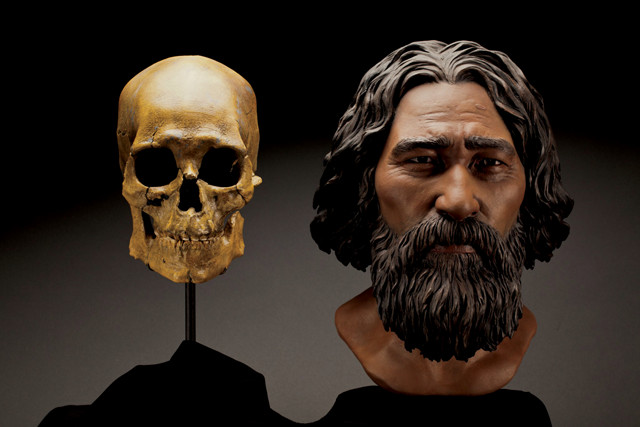
by Sara E. Pratt Monday, September 21, 2015

Cast and facial reconstruction of Kennewick Man. Previous morphometric analyses suggested he was related to the Ainu people of Japan, but a new genomic analysis shows he is more closely related to modern Native Americans. Credit: Chip Clark, Smithsonian.
After two decades of controversy surrounding the origins of Kennewick Man — a 9,000-year-old skeleton found on the banks of the Columbia River in Washington state — a genomic analysis has revealed that he was, in fact, related to modern Native Americans. The 1996 discovery of the well-preserved skeleton led to a protracted legal battle among scientists, Native American tribes and the federal government over the disposition of the remains, and sparked a scientific debate about the origins of the first Americans.
After his discovery, Kennewick Man was claimed as an ancestor by five Pacific Northwest tribes who called him the “Ancient One” and who were opposed to scientific studies of the skeleton. They wanted the remains repatriated for reburial under the Native American Graves Protection and Repatriation Act (NAGPRA).
However, preliminary morphological analysis of the skull by anthropologists, including Douglas Owsley of the Smithsonian Institution, suggested that Kennewick Man was more closely related to groups such as the Japanese Ainu and Polynesians, in which case NAGPRA would not apply. The anthropologists sued to prevent the remains from being reburied before they were studied and, in 2004, the U.S. District Court in Portland, Ore., found in their favor. The results of subsequent scientific studies — including unsuccessful attempts to extract and analyze highly degraded genetic material — were published in 2014.
Now, Morten Rasmussen and Eske Willerslev at the Center for GeoGenetics at the Natural History Museum of Denmark and the University of Copenhagen and their colleagues report that they were able to extract DNA from a small piece of hand bone from Kennewick Man. They then sequenced the genome and compared it to the genomes of other populations worldwide, including the Ainu and Polynesians.
“We find that Kennewick Man is closer to modern Native Americans than to any other population worldwide,” the authors wrote in Nature. “Among the Native American groups for whom genome-wide data are available for comparison, several seem to be descended from a population closely related to that of Kennewick Man, including the Confederated Tribes of the Colville Reservation, one of the five tribes claiming Kennewick Man.”
Many members of the same research team were involved in sequencing the genome of the 13,000-year-old Anzick infant — one of the other rare ancient skeletons found in North America — which came from the only known Clovis burial site. That analysis, published in Nature in February 2014, also found the remains to be more closely related to Native American populations than to any other worldwide.
The new findings support the idea that Native Americans have continuously inhabited North America for millennia, and that their ancestors were in fact the first people to populate the continent.
© 2008-2021. All rights reserved. Any copying, redistribution or retransmission of any of the contents of this service without the expressed written permission of the American Geosciences Institute is expressly prohibited. Click here for all copyright requests.